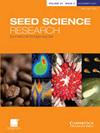How regional climate and seed traits interact in shaping stress–tolerance of savanna seeds?
IF 1.9
3区 生物学
Q2 PLANT SCIENCES
引用次数: 1
Abstract
Abstract Functional traits related to regeneration responses to the environment are highly determinants of distribution patterns of plant communities. A large body of studies on seed traits suggests that regional climate may act as a strong filter of plant recruitment; however, few studies have evaluated the relative importance of seed traits and environmental filters for seed persistence at the population level. We tested the role of seed mass, water content and desiccation tolerance, as well as the germination time as proxies for seed tolerance to environmental filters (water deficit, heat shock and high temperatures) by comparing the response of tree species co-occurring in savannas located in different regions: Cerrado biome of Central Brazil and the Rio Branco savannas of northern Brazil. Seeds collected in savannas of Rio Branco showed a higher tolerance to environmental filters than those collected in savannas of the Cerrado. While the germination percentages largely varied in response to the treatments, the germination times were virtually unaffected by them, irrespective of seed origin, seed mass and water content. At the population level, the regional environment was a key determinant of seed tolerance to stress, irrespective of seed traits. Germination time was shown to represent a conservative seed trait and more linked to a species-specific germination strategy than to regional characteristics. Our results suggest that recruitment patterns of Cerrado savannas may be more impacted than Rio Branco savannas by the climate scenarios predicted for the future.区域气候和种子特性如何在形成稀树草原种子的抗逆性方面相互作用?
与植物群落更新响应有关的功能性状是植物群落分布格局的重要决定因素。大量关于种子性状的研究表明,区域气候可能是植物招募的强大过滤器;然而,很少有研究在种群水平上评价种子性状和环境过滤器对种子持久性的相对重要性。我们通过比较巴西中部塞拉多(Cerrado)和巴西北部里约热内卢Branco稀树草原(里约热内卢Branco)不同地区稀树草原共生树种的反应,测试了种子质量、含水量、干燥耐受性以及发芽时间作为种子对环境过滤器(水分亏缺、热冲击和高温)的耐受性的作用。里约热内卢Branco在热带稀树草原采集的种子对环境过滤器的耐受性高于塞拉多热带稀树草原采集的种子。虽然发芽率在很大程度上随处理而变化,但发芽时间几乎不受其影响,无论种子来源、种子质量和含水量如何。在种群水平上,无论种子性状如何,区域环境是种子抗胁迫能力的关键决定因素。发芽时间被证明是一种保守的种子性状,更多地与物种特有的发芽策略有关,而不是与区域特征有关。我们的研究结果表明,未来气候情景对塞拉多热带稀树草原的增收模式的影响可能比对布兰科热带稀树草原的增收模式更大。
本文章由计算机程序翻译,如有差异,请以英文原文为准。
求助全文
约1分钟内获得全文
求助全文
来源期刊

Seed Science Research
生物-植物科学
CiteScore
3.60
自引率
4.80%
发文量
23
审稿时长
>12 weeks
期刊介绍:
Seed Science Research, the official journal of the International Society for Seed Science, is a leading international journal featuring high-quality original papers and review articles on the fundamental aspects of seed science, reviewed by internationally distinguished editors. The emphasis is on the physiology, biochemistry, molecular biology and ecology of seeds.
 求助内容:
求助内容: 应助结果提醒方式:
应助结果提醒方式:


